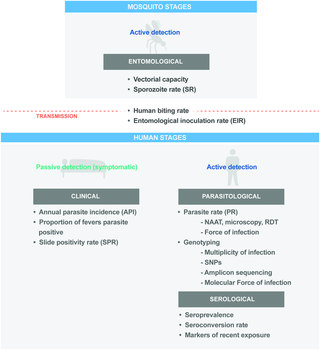Our official English website, www.x-mol.net, welcomes your
feedback! (Note: you will need to create a separate account there.)
malERA: An updated research agenda for characterising the reservoir and measuring transmission in malaria elimination and eradication.
PLOS Medicine ( IF 10.5 ) Pub Date : 2017-11-30 , DOI: 10.1371/journal.pmed.1002452
PLOS Medicine ( IF 10.5 ) Pub Date : 2017-11-30 , DOI: 10.1371/journal.pmed.1002452

|
This paper summarises key advances in defining the infectious reservoir for malaria and the measurement of transmission for research and programmatic use since the Malaria Eradication Research Agenda (malERA) publication in 2011. Rapid and effective progress towards elimination requires an improved understanding of the sources of transmission as well as those at risk of infection. Characterising the transmission reservoir in different settings will enable the most appropriate choice, delivery, and evaluation of interventions. Since 2011, progress has been made in a number of areas. The extent of submicroscopic and asymptomatic infections is better understood, as are the biological parameters governing transmission of sexual stage parasites. Limitations of existing transmission measures have been documented, and proof-of-concept has been established for new innovative serological and molecular methods to better characterise transmission. Finally, there now exists a concerted effort towards the use of ensemble datasets across the spectrum of metrics, from passive and active sources, to develop more accurate risk maps of transmission. These can be used to better target interventions and effectively monitor progress toward elimination. The success of interventions depends not only on the level of endemicity but also on how rapidly or recently an area has undergone changes in transmission. Improved understanding of the biology of mosquito-human and human-mosquito transmission is needed particularly in low-endemic settings, where heterogeneity of infection is pronounced and local vector ecology is variable. New and improved measures of transmission need to be operationally feasible for the malaria programmes. Outputs from these research priorities should allow the development of a set of approaches (applicable to both research and control programmes) that address the unique challenges of measuring and monitoring transmission in near-elimination settings and defining the absence of transmission.
中文翻译:

malERA:更新的研究议程,用于描述疟疾消除和根除过程中的储存库特征和测量传播情况。
本文总结了自 2011 年根除疟疾研究议程 (malERA) 发布以来,在定义疟疾传染源以及传播测量以供研究和规划使用方面取得的主要进展。要在消除疟疾方面取得快速有效的进展,需要更好地了解传播来源以及那些有感染风险的人。描述不同环境中传播库的特征将有助于选择、实施和评估最合适的干预措施。 2011年以来,在多个领域取得了进展。人们更好地了解了亚显微感染和无症状感染的程度,以及控制有性阶段寄生虫传播的生物学参数。现有传播措施的局限性已被记录,并为新的创新血清学和分子方法建立了概念验证,以更好地表征传播。最后,现在正在共同努力使用来自被动和主动来源的各种指标的集合数据集,以开发更准确的传播风险图。这些可用于更好地制定干预措施并有效监测消除进展。干预措施的成功不仅取决于流行程度,还取决于一个地区传播变化的速度或最近发生的变化。需要更好地了解蚊子与人类以及人与蚊子传播的生物学,特别是在低流行地区,感染的异质性明显,当地媒介生态也存在差异。新的和改进的传播措施对于疟疾规划来说必须具有可操作性。 这些研究重点的成果应有助于开发一套方法(适用于研究和控制计划),以解决在接近消除的环境中测量和监测传播以及定义不存在传播的独特挑战。
更新日期:2017-12-01
中文翻译:

malERA:更新的研究议程,用于描述疟疾消除和根除过程中的储存库特征和测量传播情况。
本文总结了自 2011 年根除疟疾研究议程 (malERA) 发布以来,在定义疟疾传染源以及传播测量以供研究和规划使用方面取得的主要进展。要在消除疟疾方面取得快速有效的进展,需要更好地了解传播来源以及那些有感染风险的人。描述不同环境中传播库的特征将有助于选择、实施和评估最合适的干预措施。 2011年以来,在多个领域取得了进展。人们更好地了解了亚显微感染和无症状感染的程度,以及控制有性阶段寄生虫传播的生物学参数。现有传播措施的局限性已被记录,并为新的创新血清学和分子方法建立了概念验证,以更好地表征传播。最后,现在正在共同努力使用来自被动和主动来源的各种指标的集合数据集,以开发更准确的传播风险图。这些可用于更好地制定干预措施并有效监测消除进展。干预措施的成功不仅取决于流行程度,还取决于一个地区传播变化的速度或最近发生的变化。需要更好地了解蚊子与人类以及人与蚊子传播的生物学,特别是在低流行地区,感染的异质性明显,当地媒介生态也存在差异。新的和改进的传播措施对于疟疾规划来说必须具有可操作性。 这些研究重点的成果应有助于开发一套方法(适用于研究和控制计划),以解决在接近消除的环境中测量和监测传播以及定义不存在传播的独特挑战。











































 京公网安备 11010802027423号
京公网安备 11010802027423号